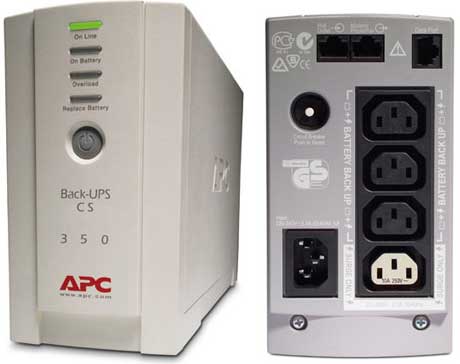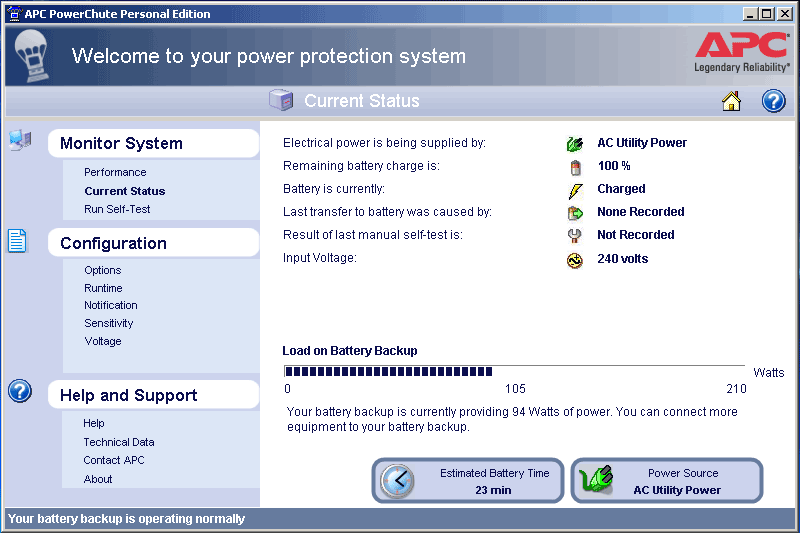
A few days ago we had a 27 minute power outage during a lightning storm near the Automated Home. Not an unusual occurrence in itself – but this one was to be more significant. After a few days of wailing and nashing of teeth here are the lessons learnt and why we now have an in-expensive but effective UPS on our server.
Death of a Drive – Sometimes a power cut or surge will kill your PSU. However, on this occasion, trying to re-start our Jukebox WHS machine we realised it was the system drive that was toast. This was the only drive we’d re-used from the old server – perhaps foolishly – a rather elderly IDE drive. We were trying to save all the SATA bays for big data drives and use the IDE line for the boot disk.
When we built our WHS box last year we said this – “Backing up the WHS system drive seems to be the weak link in the current version [of Windows Home Server]. From what we can see there’s no easy way to do this, bar having a separate RAID 1 system just for it. The partnership between the C: partition and the D: storage pool partition needs to be in sync, so imaging the OS drive with Acronis / Ghost or similar will be out of date and therefore useless shortly after it’s been done. However if the system disk does die you should be able to install a new version of WHS on a new disk which will then re-gain you access to your un-harmed data, albeit with the loss of any add-ins or other customisation to WHS you had.”
Lucky – And that turned out to be pretty accurate – our data did survive (phew), but there’s still considerable pain and down time involved in getting things back up and running again. The machine has to come out of the rack, lid off, dead drive swapped out for a new one. This is followed by hours of the OS reinstall (make sure you choose Server ‘Reinstall’ in a case like this – see the FAQ). Then there are drivers to find, critical updates and reboots. As we said above, all customisation is lost too. Our server was backing up the most important files to an external USB drive using SyncBack, as well as a 30GB backup to the cloud using JungleDisk.com. These apps had to be re-installed and configured, plus our most important WHS addon – Disk Manager – had gone too, requiring more work.
Add to this the disappointment factor when the rest of the household can’t access their video or music files for several days and you realise why £60 spent on a UPS suddenly looks like very good value for money.
Of course this part of the story has an air of closing the stable door after the horse has bolted, but we want to make sure this doesn’t happen to us (or you) again.

APC PowerChute – Click for full size version
Never Again – We still imagined a UPS was an expensive beast – we were wrong. We looked around for a suitable model and chose the £60 APC Back-UPS CS 350 after a recommendation. It’s a neat little unit, silent and with support for many OS’s including WHS. We like the way its battery is easily removed for replacement in the future too.
Our server consumes around 100 Watts and the APC software predicts around 25 minute running time on its battery. In our experience that will keep it up during most power cuts – a good 90% of which are of the ‘flicker’ or the off for a second or two and then back on variety. Importantly it protects the server from power surges too.
The UPS software runs on the server and communicates with the battery pack via USB (or serial). In the event of a longer power cut the software will initiate a controlled shut down or hibernation of the server before its battery runs flat – ensuring your data is safe from corruption.
The unit has 4 x C14 IEC sockets on the rear. 3 of them are battery supplied with a fourth offering surge protection alone. You can easily create an extension board in your Node Zero supplied from one of the battery sockets. It’s easy to plug in your (relatively low powered) router, wireless access point, switch etc so your server and laptops could continue to access the internet during a power cut (providing the phone service remains up – as is often the case). The CS 350 also has an RJ-45 Modem/DSL socket to protect your router from surges too.
Play not Work – So gone are the days when a UPS was an expensive luxury or only found in business server rooms. Now there’s no excuse for not giving your data that extra layer of protection, and giving you peace of mind. Lets spend those hours and days watching our movies and listening to our music, rather than re-building servers!
No products found.
Available from Amazon : WHS Server Failure FAQ : Building Our DIY WHS
Last update on 2024-11-09 / Affiliate links / Images from Amazon Product Advertising API

Your WHS consumes about 100w, with the UPS hooked in how much is the setup using now, Iwas under the impression that UPS’es used alot of power?
If you have ever lost data or equipment during a power outage, then you will feel that the UPS is well worth it.
A UPS consumes very little power itself.
They are normally 90%-95% efficient, meaning if the computer *USES* (not what the power supply is listed for) 100Watts, then the UPS may consume 5-10 Watts.
I use them liberally in my house. Computers, TV’s, DVR’s, etc.
Near same thing happened to our Server a few years back. Luckily for us it was only corrupted Master Boot Records that caused our panic. We have used an APC UPS linked into WHS ever since. It has paid for itself several times over. GET ONE NOW OR BE SORRY.
The true running cost of a UPS also has to include the provision of replacement batteries every few years too, which is a significant cost on larger units. Even so it’s still much lower than the time/hassle cost should a glitch similar to this story happen.
Fair point for larger units (I used to run a rack mount monster UPS). However a replacement battery for this unit us around £17.00 – pretty insignificant.
We always try and sell our home users a UPS but it’s very difficult to educate them, that is until they come back after a powercut but the damage is done.
Please thou if buying a UPS you get what you pay for , these cheap £25-35 ones are not worth it. They don’t filter the mains, have the option for replacement batteries and degrade within a year.
We learnt buy this and only sell apc now so good choice Mark.